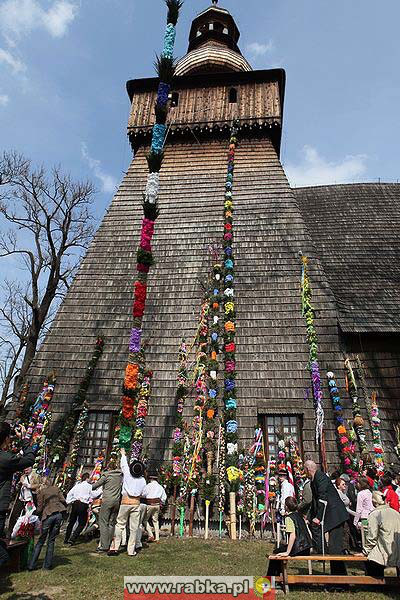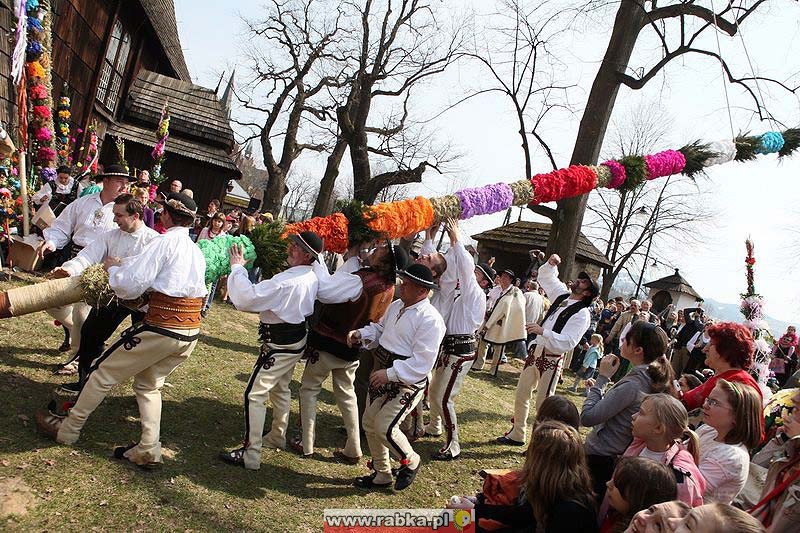Beautiful Easter Palms in Poland and history behind them Posted by Kasia on Mar 20, 2016 in Culture, Religion
Poland is a country full of unique traditions and customs, especially when it comes to holidays. As Easter is one of the most important holidays, I would like to tell you a few things about it so you won’t be surprised if you get a chance to celebrate it in our country.
As you might know the entire week before Easter is called Holy Week, and during that time there’s a lot of things going on here.
Palm Sunday (Niedziela Palmowa) is called also The Sunday of the Lord’s Passion ( Niedziela Męki Pańskiej), Willow Sunday (niedziela wierzbowa).
Exactly 7 days before the main celebrations take place, people gather for a procession with palms in their hands. This is the moment when they begin to celebrate. Where do Polish people take the real palms from? It’s too cold for them to grow there! In Poland, all we can get are ‘artificial palms’ (sztuczne palmy). They’re usually made from branches of native trees, including box, willow, yew and olive.
Every year, palm competitions take place throughout Poland. Two notable ones are held in Łyse in the Kurpie region, and in the village of Lipnica Murowana, southwest of Krakòw.
The village of Łyse holds a contest for the tallest and most beautiful palm. People from all over the region work hard for the forty days of Lent to make their entries.
The palms in Lipnica Murowana are so tall, they cannot be carried upright and are transported to the main square or church yard by several men who hoist them up so they stand on end.
The most popular palms that people usually carry to the church are made of blooming pussy willows branches called bazie or kotki decorated with branches of birch, raspberry, currant and also some boxwood bukszpan, dry flowers and grass, ribbons and other decorations. In the Catholic Church the willow (Polish: wierzba) symbolizes the resurrection and the immortality of the soul.
The decorated branches are called ‘palms’ as a reference to the bilbical entry of Christ into Jerusalem, but these celebrations show many remnants of old-Slavic customs of welcoming of the spring, native to Poland. This include the form and materials, or the way of preparing and later storing the symbolic ‘palms’.
The ancient Slavic spring feast was synctretized with the Christian celebrations of Lents and Easter over the centuries. In the years when Easter falls in late March (Easter is a movable feast), the ‘palms’ are sometimes still accompanied also by the effigies of Marzanna (Slavic winter goddess that is ‘drowned’ in Poland around the spring equinox).
After the blessing in churches the ‘palms’ were often symbolically ‘planted’ on crop fields to ensure a good harvest in the upcoming year. In some regions they were also used for blessing of the cattle or houses with sprinkled water. Later they are included among Easter decorations of the houses, often put on tables for the Easter breakfast, and in the past they used to be attached to religious paintings as an adornment throughout the later spring months. It was considered a sin to throw away an ‘Easter palm’. They were often stored in the house and symbolically burnt (connected to old beliefs of fire being a cleansing force) only a year later, when a new blessed Easter palm was brought home.
This week keep an eye out for more posts about Easter traditions in Poland!

Build vocabulary, practice pronunciation, and more with Transparent Language Online. Available anytime, anywhere, on any device.
About the Author: Kasia
My name is Kasia Scontsas. I grew near Lublin, Poland and moved to Warsaw to study International Business. I have passion for languages: any languages! Currently I live in New Hampshire. I enjoy skiing, kayaking, biking and paddle boarding. My husband speaks a little Polish, but our daughters are fluent in it! I wanted to make sure that they can communicate with their Polish relatives in our native language. Teaching them Polish since they were born was the best thing I could have given them! I have been writing about learning Polish language and culture for Transparent Language’s Polish Blog since 2010.






Comments:
Thaddeus Figlock:
Sincere thanks for this message with cultural and religious content. Ted Figlock, W1HGY.
pigus skrydis:
What an interesting tradition at Poland! I have never seen something before like that 🙂 Even I visited a lot of countries, traveling with cheap airlines, in whole Europe there is nothing similar like that 🙂 I thing that and this Eastern polish people will celebrate like that also.